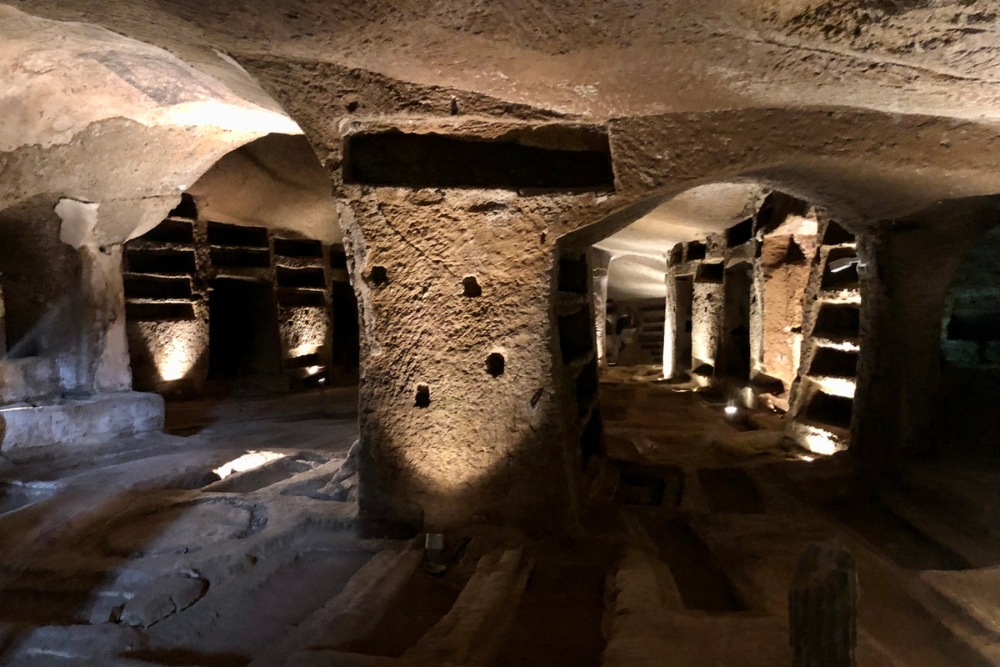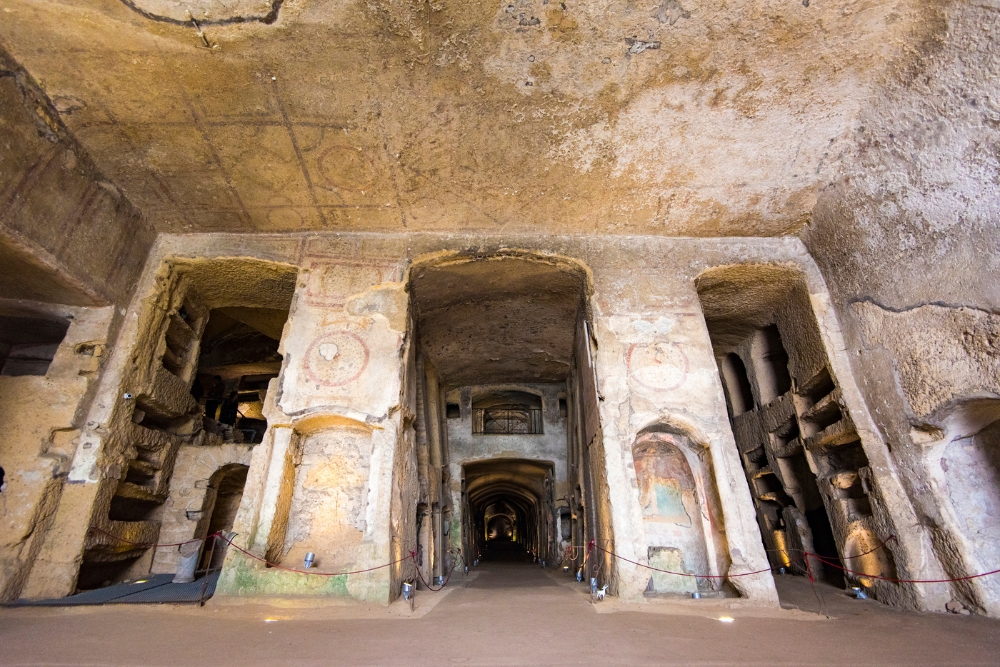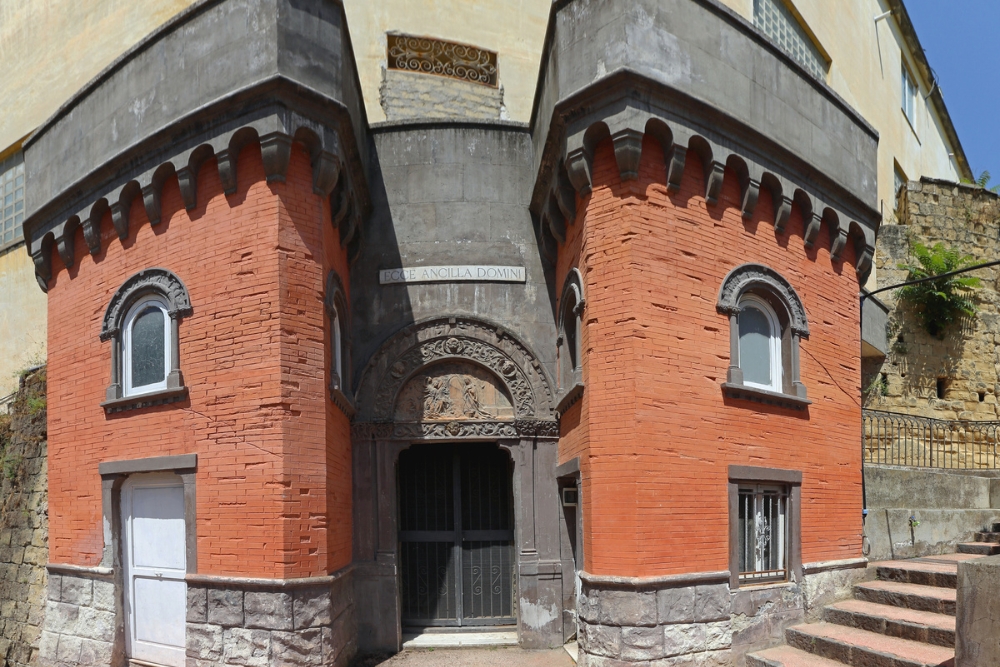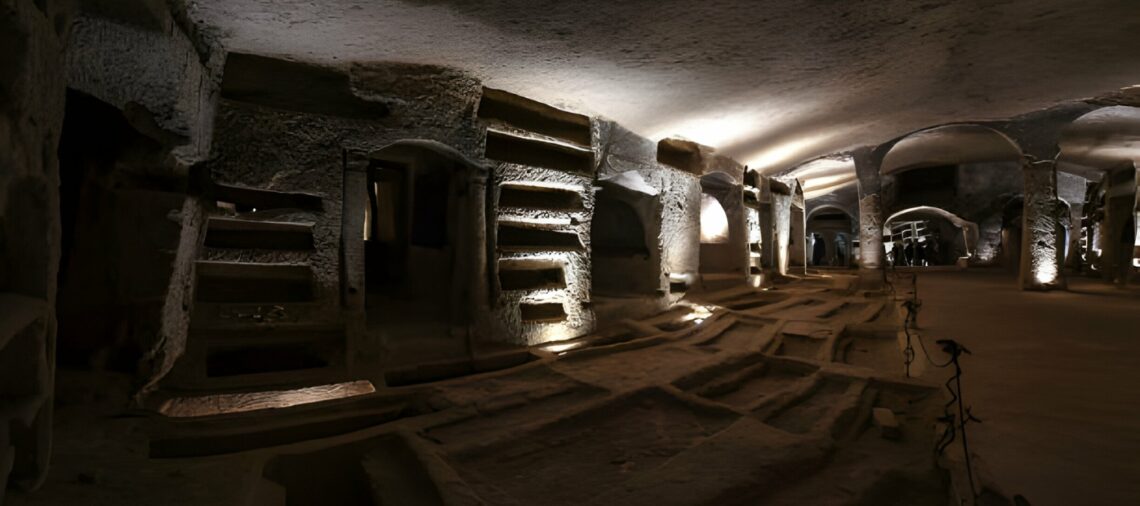The Catacombs of San Gennaro are a fascinating network of underground burial sites in Naples, Italy. Dating back to the 2nd century AD, these catacombs served as a final resting place for early Christians and later became a place of pilgrimage. The catacombs have different levels and corridors, all adorned with frescoes, sculptures, and tombs.
The most notable feature is the crypt of San Gennaro, the patron saint of Naples, where his remains were originally interred. These catacombs provide a unique insight into the burial practices and religious beliefs of ancient Romans and early Christians, making it a significant historical and cultural site. Visitors can explore the various chambers and gain a deeper understanding of the rich history and spirituality of the region.
Importance of the Catacombs of San Gennaro in Italian history and culture

The Catacombs of San Gennaro hold immense importance in Italian history and culture. These underground burial sites symbolize the region’s rich heritage and its connection to the early Christian era. The catacombs not only provide valuable insights into the religious practices and beliefs of early Christians, but they also serve as a reminder of the enduring faith and resilience of the Neapolitan people. Furthermore, the catacombs have become a significant pilgrimage site, attracting visitors from all over the world who are eager to explore the fascinating history and artistic treasures hidden within these ancient underground tunnels. Thus, the Catacombs of San Gennaro stand as a testament to the profound influence of religion and the preservation of cultural heritage in Italian society.
History of the Catacombs of San Gennaro
The Catacombs of San Gennaro have a rich and fascinating history that dates back to the Roman Empire. The origins and early development of these catacombs can be traced to the influence of the Roman Empire on burial practices. During this time, cremation was the most common method of disposing of the deceased. However, the spread of Christianity brought about a change in burial customs, as Christians believed in the resurrection of the body and therefore preferred burial over cremation.
As Christianity gained prominence in the Roman Empire, the emergence of Christian burials in catacombs became increasingly common. The catacombs of San Gennaro were one of the many underground burial sites created during this time. These catacombs provided a safe and sacred space for Christians to bury their dead and also served as places of worship and pilgrimage.
The catacombs of San Gennaro became particularly important due to the presence of the relics of Saint Gennaro, the patron saint of Naples, which attracted numerous pilgrims throughout the centuries. This blend of religious significance and practicality contributed to the growth and development of the Catacombs of San Gennaro as an important cultural and historical site.
Role of the Catacombs of San Gennaro during the Persecution of Christians

The Catacombs of San Gennaro played a crucial role during the persecution of Christians in ancient Rome. Firstly, they served as a sanctuary for worship and hiding. As the Roman Empire sought to suppress the growing Christian community, believers were forced to practice their faith in secret. The catacombs provided a haven where Christians could gather to worship, conduct religious ceremonies, and hold services away from the prying eyes of the authorities. These underground tunnels and burial chambers became not only places of solace but also vital spaces for preserving the Christian faith in times of adversity.
Secondly, the catacombs held great symbolism and religious significance for the early Christian community. The underground nature of these burial sites represented a connection to the underworld, mirroring the journey of Christ’s crucifixion, death, and resurrection. The catacombs became a physical manifestation of the Christian belief in life after death and the hope of salvation. The walls of the catacombs were adorned with frescoes and inscriptions depicting scenes from the Bible, emphasizing the Christian narrative and providing comfort and inspiration to those enduring persecution. These artworks and symbols were a powerful reminder of their faith and a source of strength during challenging times.
Lastly, the catacombs were places of refuge and symbolism and vital for preserving Christian history and tradition. The underground chambers became the final resting place for many early Christians, allowing their faith to unite them even in death. The catacombs served as a tangible link to the past, where the early Christian martyrs’ stories, teachings, and sacrifices were honored and remembered. These underground burial sites also acted as repositories for Christian relics, including the remains of saints and martyrs, which were venerated by the faithful. Through the catacombs, the early Christian community maintained a sense of continuity and identity despite the persecution they faced.
Rediscovery and restoration efforts regarding the Catacombs of San Gennaro

Historical context of the 17th-century rediscovery
The catacombs, originally used as burial grounds for early Christians, fell into obscurity during the Middle Ages. However, in 1629, the catacombs were accidentally rediscovered by a group of workers during the construction of a new aqueduct. This accidental rediscovery sparked great interest in the catacombs’ historical and cultural significance, leading to extensive documentation and exploration efforts. Scholars and archaeologists were fascinated by the intricate network of underground tunnels and tombs, which provided valuable insights into early Christian burial practices and iconography. The rediscovery of the Catacombs of San Gennaro in the 17th century marked the beginning of renewed efforts to preserve and protect this significant historical site.
Ongoing preservation and conservation projects
The Catacombs of San Gennaro have been the subject of ongoing preservation and conservation projects to safeguard this invaluable historical site. In recent years, concerted efforts have been to restore the catacombs and make them more accessible to the public. These projects have used advanced conservation techniques to stabilize and protect the ancient frescoes, sculptures, and other artifacts found within the catacombs.
Additionally, implementing climate control systems and improved lighting has helped mitigate the potential damage caused by humidity and inadequate lighting conditions. Furthermore, ongoing research and documentation efforts are crucial for understanding the catacombs’ historical significance and supporting their long-term preservation. The collaborative efforts of archaeologists, historians, and conservation specialists have played a crucial role in ensuring that future generations can appreciate and learn from the Catacombs of San Gennaro.
Legends and Miracles Associated with the Catacombs
The catacombs of Naples are shrouded in legends and tales of miracles, with one of the most well-known being associated with San Gennaro, the patron saint of Naples. San Gennaro, also known as Saint Januarius, is said to have a deep connection to the catacombs. According to popular belief, his remains were brought to the catacombs after his martyrdom in the early 4th century. It is believed that his relics were hidden in the catacombs to protect them from persecution, and they remain an important pilgrimage site for Catholics to this day.
The annual miracle of the blood liquefaction further strengthens San Gennaro’s connection to the catacombs. Each year, on September 19th, the anniversary of the saint’s martyrdom, his blood, preserved in a vial, is said to be miraculously liquefied. This event draws thousands of devotees to the Naples Cathedral, where they gather in prayer and anticipate witnessing the miracle. The blood liquefaction is seen as a sign of protection and blessing from San Gennaro, and it holds great significance for the people of Naples.
The annual miracle of the blood liquefaction is deeply rooted in popular devotion to San Gennaro. The veneration of the saint and the belief in his miraculous powers are strong in Naples and its surrounding areas. The tradition of blood liquefaction dates back centuries, and its continuation reflects the enduring faith and devotion of the local community. The event is not only a religious ceremony but also a cultural and social gathering, with processions, music, and festivities that highlight the importance of San Gennaro as a unifying figure for the people of Naples.
How To Visit the Catacombs of San Gennaro

The Catacombs of San Gennaro, located in Naples, Italy, are an intriguing tourist attraction and educational site that offer a unique glimpse into the city’s ancient past. To visit the catacombs, having some practical information beforehand is important. Firstly, booking tickets in advance, especially during peak tourist seasons, is advisable to avoid long queues. Tickets can be purchased online or at the ticket office on-site. It is also essential to wear comfortable shoes and clothing as the catacombs involve walking through narrow passageways and stairs.
The catacombs are open to visitors every day (except Wednesdays), with guided tours available in multiple languages. The guides provide valuable insights into the historical and cultural significance of the catacombs. The tour typically lasts for about an hour and takes visitors through various chambers, including the Crypt of the Bishops, the Crypt of St. Gaudiosus, and the Crypt of St. Severus. These crypts house intricate frescoes, sculptures, and early Christian burial sites, offering a fascinating glimpse into the early Christian community of Naples. The standard price of a tour is 11 euro.
Additionally, it is important to respect the rules and regulations of the catacombs during the visit. Flash photography is strictly prohibited to preserve delicate artwork and prevent any damage. Visitors are also requested to maintain a respectful and quiet demeanor throughout the tour, as the catacombs hold religious significance for many. A visit to the Catacombs of San Gennaro provides a unique opportunity to explore the ancient history of Naples. It offers a memorable educational experience for tourists and history enthusiasts alike.
Final Thoughts about the Catacombs of San Gennaro
In conclusion, the Catacombs of San Gennaro hold a significant historical and cultural value that cannot be understated. These ancient underground burial sites offer a remarkable glimpse into the past, shedding light on the lives and traditions of those who lived centuries ago. The intricate frescoes, unique architecture, and the presence of numerous saints’ relics make this underground labyrinth a truly awe-inspiring experience.
Visiting the Catacombs of San Gennaro allows us to connect with our past and serves as a reminder of the fleeting nature of life. It is a humbling experience that prompts introspection and appreciation for the legacy left behind by our ancestors.




